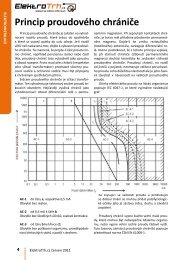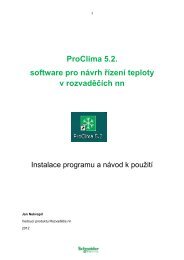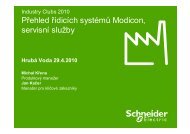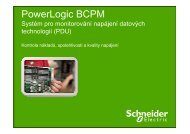2 - Schneider Electric CZ, s.r.o.
2 - Schneider Electric CZ, s.r.o.
2 - Schneider Electric CZ, s.r.o.
You also want an ePaper? Increase the reach of your titles
YUMPU automatically turns print PDFs into web optimized ePapers that Google loves.
Presentation<br />
SoMachine software &<br />
Application Function Blocks library<br />
Improving reliability and maintenance<br />
Wind speed control<br />
> > Construction cranes<br />
Typical applications<br />
> > Self-erecting cranes<br />
> > Tower cranes<br />
Detect high wind events<br />
The wind speed control function constitutes a preventive measure against risk<br />
associated with strong winds. It is based on an anemometer and a controller that<br />
detects and sends an output signal to inform operators that maximum wind speed<br />
has been exceeded to continue operations.<br />
Benefits<br />
Reduce risks<br />
> > Prevents the crane from toppling over.<br />
Reliable control system<br />
> > Detection of lock or failure of the anemometer<br />
> > Crane control is restricted to prevent the risk of unauthorised operation.<br />
Flexible and customized<br />
> > Adjustable filter time to prevent gusts of very short duration from triggering false<br />
alarms<br />
Warning and alarm setpoints configurable according to local regulations<br />
> > Anemometer with analogue output or pulsed output is allowed.<br />
Optimized and compact installation<br />
> > A dedicated monitoring device is not required; the same controller can be used<br />
for several functions.<br />
Complete diagnostic<br />
> > The most recent excessive wind speed events, with time and date, are recorded<br />
as part of the preventive maintenance and monitoring.<br />
Operating principle<br />
The anemometer detects the speed of the wind by generating an analogue or pulsed<br />
output and the controller sends a pre-alarm by activating a flashing light (orange)<br />
and intermittent audible signals when wind speed is higher than 50 km/h. .<br />
At the same time the function sends a maximum wind overspeed warning (72 km/h in<br />
standard cranes, configurable according to local regulations) with a steady light (red)<br />
and continuous audible signal indicating to the operator that crane could be parked<br />
on a free slewing jib. The system registers and resets this alarm when the crane is<br />
out of service or after a preset time configurable by user.<br />
Characteristics<br />
The wind speed control function is based on an anemometer and a controller. Two<br />
beacons, an orange and a red light with an audible signal, are needed. At the same<br />
time the operator can view the wind speed information on a display, including the<br />
dates and times of the most recent speed events, on a display.<br />
1<br />
2<br />
3<br />
4<br />
5<br />
6<br />
7<br />
8<br />
9<br />
10<br />
2/9
















